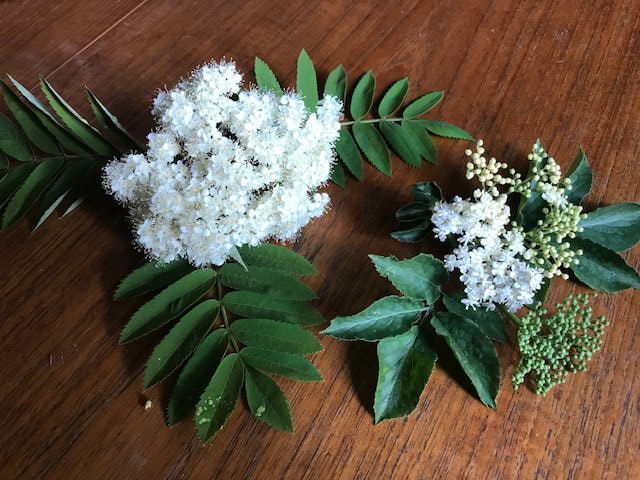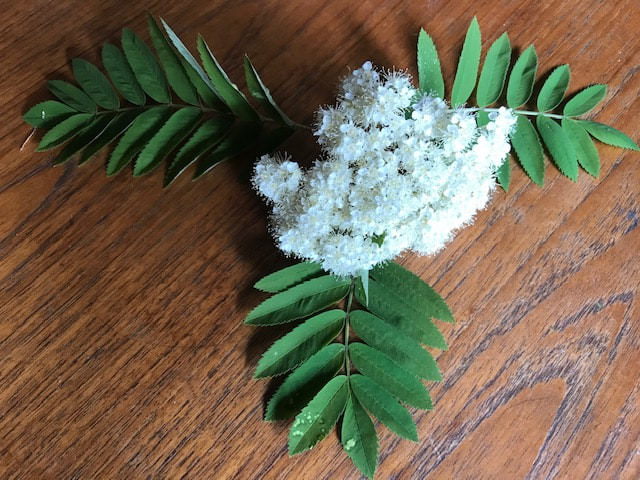

I’ve written about elder (Sambucus nigra) before; the elder tree has been used since ancient times for its medicinal properties. In fact it was once considered to be the “Medicine Chest Tree” as all its parts can be used to treat common ailments. Elderflowers are traditionally used for the treatment of colds and influenza. They are indicated in any catarrhal inflammation of the upper respiratory tract such as hayfever and sinusitis. For colds and flu it makes a great tea, combined in equal parts with peppermint and yarrow. For hayfever its best combined with nettle, plantain and chamomile.
Elderflowers are rich in bioflavonoids, mostly flavones and flavonols, that are most commonly known for their antioxidant, anti-inflammatory and antibacterial properties. The most abundant flavonols in elderflowers are quercetin, isoquercitrin and anthocyanins, which have antiviral properties as well. Elderflower also contains chlorogenic acids, such as cinnamic acid, which may help with allergies, regulate blood glucose levels and have a slight laxative effect on the body. Triterpenoids, especially β-amyrin, erythrodiol, and oleanolic acid, are also found in elderflower. These triterpenoids offer a variety of health benefits including analgesic and anti-inflammatory.
As well as being brewed into tea, elderflowers are great turned into cordial, tincture and elderflower champagne. I’m going to share a few recipes below. But first I want to answer a common question I get asked:
How to identify elderflower:
One of the main things that puts people off foraging is, can they be sure they are correctly identifying what they pick?
Its good to be cautious, but it does get easier. And once you have observed plants through all the seasons (so you see them in new leaf, then flower and fruit) you will start to feel more confident.
The elder generally grows as a shrub or small tree that grows in woodlands, hedgerows and scrub, on waste ground, railway embankments and in graveyards.



The first picture above is Elder. Its leaves are whats known as compound and pinnate (feather shaped) with five or seven leaflets. Leaflets are arranged opposite each other with one single leaflet at the tip. The edge of each leaflet is toothed and there may be small hairs on the underside. In winter, leafbuds are purplish and spikey-scaled.
The second picture is Rowan it has smaller leaflets, maybe as many as 10 on each side, they are usually hairless, dark green above and grey green below. The Rowan flower heads are rather domed on top and very “blowsy” and smell unpleasant, whereas the elder flower heads are pretty flat on top and smell just delightful.
I found these two trees growing next to each other so that some of their branches were intertwined. It was only when I noticed the different leaves that I realised it was two different trees. However when placed next to each other you can see a big difference in the flower heads too. Rowan flowers are larger than elderflowers and have brown/black anthers and an almost hairy appearance due to the number of stamen protruding from each flower. Contrast with the delicate white stamens and yellow anthers on elderflower.
If you observe the trees over more seasons you will also discover that the Elder produces clusters of small purple-black berries on red-pink stalks whereas Rowan produces round, fleshy red berries, up to 10mm across. They are orange at first, with yellow flesh. They ripen in September and each has between 2 and 8 seeds (usually 3 or 4). Each fruit has a tiny “star” in the middle which is a remnant of the calyx and reminds us, that it belongs to the same family as dog rose.Other plants to be wary of confusing with Elder include:
Cow parsley, cowbane, pignut, hemlock, pyracantha, red osier dogwood and hawthorn.


Cow parsley, cow bane, hemlock and pignut all grow on stalks, directly from the ground, rather than a tree or bush. These plants also lack the surrounding leaves (with serrated edges) that you find with elderflower.
Cowbane flowers also do not have 5 rounded petals – instead the petals are somewhat ragged and lack the white stamens and yellow anthers of elderflower.
IMPORTANT: Hemlock is a highly poisonous plant that grows on a green stalk (with purple blotches) directly from the ground, and looks very similar to the cow parsley. Do not confuse hemlock and elderflower!



Pyracantha flowers are larger, paler and more tightly packed than elderflowers. They have brown anthers, unlike elderflowers yellow ones.
Red osier dogwood flowers have 4 pointed petals. (Elderflower has 5, rounded petals). The leaves have a smooth edge unlike Elder leaves with their slightly serrated edge.
Hawthorn flowers are larger than elderflowers and have brown/black anthers in contrast with the delicate white stamens and yellow anthers on elderflower.
Once you have your correctly identified elderflowers, please follow foraging etiquette which includes:
Do not take more than you need. Only pick from abundant populations and leave plenty behind for wildlife and others to enjoy. Over-picking is not sustainable and will impact next year’s crop.
Do not trespass to forage for wild food. You should only forage on property that you have gained landowner’s permission to enter. Always leave it as you found it in the first place.
Leave no trace behind and respect nature. Minimise damage to the habitat and species. Do not disturb wildlife and avoid unnecessary trampling.
Use a knife / pair of scissors. Using adequate tools avoid excess damage to plants and inadvertent uprooting, increasing the chance of the plant to continue growing healthy.
And then you can start with some delicious recipes.
Easy elderflower cordial:
To make approx. 2 litres you will need:
About 25 freshly picked elderflower heads (best picked in the morning on a dry day)
Finely grated zest of 3 unwaxed lemons and 1 orange, plus their juice (approx. 150ml in total)
1 kg sugar
1 heaped tsp of citric acid (this acts as a preservative. It brings a lot of tang to the cordial and has a role in extracting the flavour from the elderflowers.
Large bowl
Muslin cloth or very fine sieve
Funnel
Glass bottles
- Inspect the elderflower heads carefully and remove any insects. Place the flower heads (snipping away and discarding as much stem material as possible) in a large bowl together with the orange and lemon zest.
- Bring 1.5 litres water to the boil and pour over the elderflowers and citrus zest. Cover and leave overnight to infuse.
- Strain the liquid through a fine sieve or piece of muslin and pour into a saucepan. Add the sugar, the lemon and orange juice and the citric acid
- Heat gently to dissolve the sugar, then bring to a simmer and cook for a couple of minutes. (This sterilises the cordial by killing off any wild yeasts, bacteria or spores that will cause it to spoil).
- Use a funnel to pour the hot syrup into sterilised bottles. Seal the bottles with swing-top lids or sterilised screw-tops.
This cordial is delicious diluted with chilled sparkling mineral water, alternatively you can add a splash or two, undiluted, to fruit salads, or dilute one part cordial to two parts water for fragrant ice lollies.
Elderflower liquer:
First a bit of herbal info for you, because I just cant help myself 😉
One of the fun things about being a herbalist is that once you have learnt the basics of tincture making, you can then start to play with using these skills to create delicious flavour combinations, to make your own infused alcohols and liquers.
What is a tincture?
In a nutshell a tincture is an alcoholic extract of the active constituents of a plant (which depending on the plant may be made from bark, berries, flower leaf or root)
Commercial preparations are made with ethanol alcohol, but for home tinctures vodka is suitable for extraction.
When you buy a commercially prepared tincture it will have its strength written on the bottle ie: Calendula officinalis 1:5 25%. This means that there is one part dry herb to 5 parts liquid of which 25% is alcohol.
As a guideline it is recommended to use the following quantities when making vodka tinctures:
Fresh plants
Use 100g of fresh plant material to 100mls of vodka. This will give you an approx 1:5 25% tincture.
Dried plants
Use 50g of fresh plant material to 160mls of vodka and 90mls of water. Again this will give you an approx 1:5 25% tincture.
Making a Tincture
Place your cut or broken or crushed herbs into a sterile wide-mouthed glass jar.
Pour on the required amount of alcohol followed by the required amount of water.
Cover the jar tightly and leave it to macerate for 2-3 weeks, shaking it every day.
Strain off and store in an amber glass bottle in a cool, dark place.
Label with plant name, strength or tincture. I’ll be talking a bit more about tinctures in a future blog.
Now using these same principles we can make a delicious Elderflower liquer which is a cooling and elegant flowery drink for summer days when relaxation is in order.
Ingredients
- 80 proof vodka
- Elderflowers
- Lemon zest
- Cardamom pods lightly crushed
Instructions
- Place elderflower florets (snipping away and discarding as much stem material as possible) about 2/3 up the capacity space of a jar.
- Add lemon zest (approximately one lemon for each litre of alcohol used) and crushed cardamom pods (approximately one tablespoon per litre of alcohol used), then fill the jar with vodka.
- Place in a cool dark place to steep for four to six weeks or until the liqueur is flavored to your liking.
- Strain through muslin and decant into sterilised bottles for storage. Serve with lemonade or tonic water
Cheers!


Thanks for that, very useful information and recipes. Definitely will use recipe for liquor:-)
Hi this is genuinely the most helpful and well rounded information about elderflowers that Ive come across. Really interesting and practical. Thank you!
Thanks Cari, I tried to answer all the questions I had when I first started foraging. I appreciate the feedback